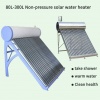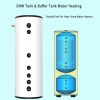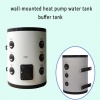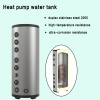Why does dual supply require a buffer water tank
Under standard operating conditions, the number of starts and stops of the main engine (i.e. the number of compressor starts) is an important parameter to measure the service life of the main engine, similar to the correlation between the service life of a home light switch and the number of turns on and off. Increasing the buffer water tank is equivalent to increasing the energy storage of the system, stabilizing the temperature change of the system, naturally reducing the number of starts and stops of the host, and extending its service life. In addition to the above advantages, what are the unique functions of the buffer water tank?
The bottom outlet of the buffer water tank is connected to the suction port of the water pump. The water entering this suction port is gas free (gas cannot come down from the upper part of the water tank), and the cavitation phenomenon of the water pump impeller will be greatly reduced. The water sucked in is pure water, and the water circulating by the water pump will naturally push the gas in the system to the system outlet, and then enter the upper inlet of the buffer water tank. The gas brought by the system outlet will be forcibly discharged by the exhaust valve at the top of the water tank, forming a virtuous cycle. In the non buffered water tank system, the water pump sucks in water containing gas, and the impeller will break the gas into pieces and transport it into the system, causing gas to exist everywhere in the system, making exhaust more difficult. The frequent alarm and continuous start/stop of the flow switch of the water pump greatly increase the difficulty of debugging.
2. Avoiding high voltage protection of the host
The water entering the motherboard for exchange is pure (without gas) water, which can better exchange energy and increase heat exchange efficiency.
3. Easier debugging and faster end effects
When the system is filled with half of the water, debugging can begin. The water flowing into the host and water pump is pure and free of gas, and the heat will be quickly transported to the end, greatly reducing debugging time. Debugging a villa without adding a buffer water tank cannot be completed within three to four hours because the water contains too much gas, the flow switch often alarms, and the host does not exchange enough heat, resulting in high-pressure protection. After the air in the fan is blocked, the effect is not significant. It greatly prolongs the debugging time. In a computer room system with a buffer water tank, the debugging work can generally be completed in one to two hours.
4. More thorough system drainage to prevent system blockage
The impurities in the pipeline are constantly circulating because after passing through a vertical large capacity water tank, many impurities will accumulate at the bottom of the buffer water tank. The water quality after passing through the Y-shaped filter is much better, thereby reducing the number of times the filter is cleaned. The drain outlet of the buffer water tank is set at the bottom of the water tank and equipped with a manual drain valve, making cleaning more convenient.
5. Winter heating ensures more stable system operation
When using small air-cooled heat pumps in severe winter, adding a buffer water tank can store a certain temperature of water in the water tank to meet the end cycle when the main unit defrosts, completely avoiding fluctuations in indoor temperature during the main unit defrosting.
6. Faster usage effect after startup
Because after the first startup, the previous cooling or heat will be stored in the buffer water tank, and the insulation standard of the buffer water tank is consistent with the standard of the hot water tank (24 hours ± 3 ℃), the effect will naturally come faster in the next use. For example, in daily life, turning off the main engine one hour before work only relies on the energy of the buffer water tank. By circulating it through the water pump, it can completely meet our needs until work.
7. The buffer water tank serves to protect the host
The buffer water tank can effectively solve the load fluctuation and frequent startup problems caused by a small system, mainly extending the startup time of the host, reducing the number of starts and stops of the host, protecting the lifespan of the host, and achieving the goal of energy conservation (pollution discharge, exhaust).




